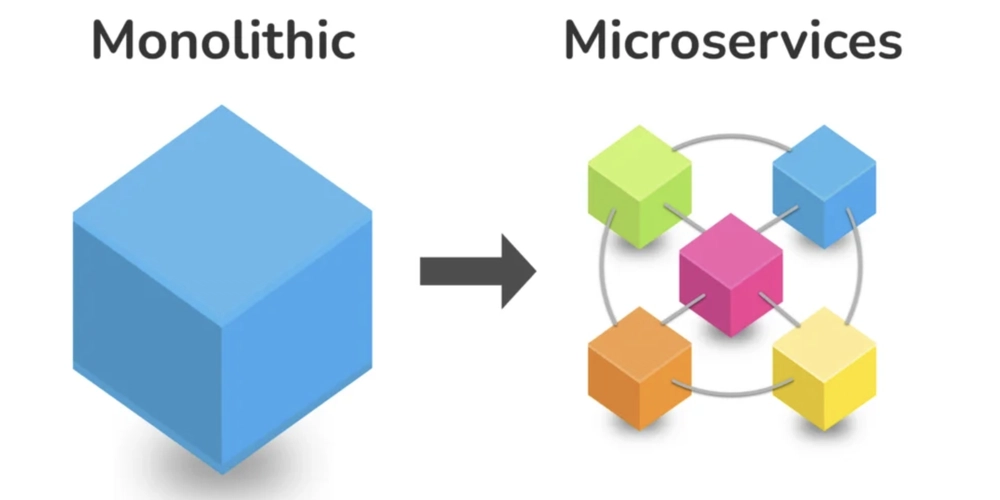The Great Microservice Delusion: How We Broke the Monolith and Our Will to Live
It started, as most tech disasters do, with a meeting. Somewhere in a glass-walled room full of sticky notes and ambition, someone declared, "Let's break up the monolith!" Cue the slow clap. Champagne may or may not have been popped. Diagrams were drawn. Visions of Netflix-scale greatness danced in our heads. Six months later, we had 42 microservices, three of which were mysteriously called auth-service, none of which agreed on what a user was, and our deployment pipeline looked like a Rube Goldberg machine built during a nervous breakdown. Congratulations. We had achieved "distributed hell". This article is for every brave soul who has ever uttered the words "We should go microservices" without first updating their life insurance policy. It's also for those who've been burned and are now huddled in the glow of a monolithic comeback. Let's talk architecture—real talk. The Monolith: Villain or Misunderstood Introvert? Let's start with the punching bag of modern architecture: the monolith. It's big, it's old and it's probably written in Java 8 or another decade old version of any language. Like that one drawer in your kitchen that has batteries, duct tape and a mysterious key to a forgotten door—it holds everything. But you know what? That drawer works. It's reliable. It has character. The monolith gets a bad rap because of its size, but size isn't the enemy—complexity, without boundaries is. A well-structured monolith can outperform a poorly planned microservice mess every single day, and you won't need a PhD in Kubernetes just to run tests. Lesson: If your monolith is a mess, splitting it into smaller messes won't help. That's just distributing dysfunction. Microservices: Now with More Opportunities to Fail! Ah, microservices. The siren song of scalability. The dream of team autonomy. The promise of being "cloud-native", whatever that means this week. And then reality hits. That one service that only runs on Tuesdays for no discernible reason. The "cascading failure" where one service times out, causing another to retry until everything catches fire. CI/CD pipelines so complex they require a wiki, a sherpa and emotional support. We promised agility and we got fragility. Microservices can work, but they demand: Discipline. Monitoring. Observability. Contracts between services. Governance. (Yes, I know that word makes developers itchy, but suck it up.) Analogy Time: Microservices are like kids. Everyone wants one until they realise you have to feed them, teach them and make sure they don't punch each other over shared toys (databases). Service Boundaries: Or, How to Play API Jenga with Your Sanity Here's a fun game: Ask your team to define the boundaries of the user-service. Watch as the room descends into philosophical debate about the nature of identity, ownership and whether storing profile pictures counts as a "core concern". One of the greatest sins in microservices is drawing boundaries based on your org chart. Just because there's a "Payments Team" doesn't mean "payments" deserves its own service or ten services. Boundaries should be based on domain, not on team silos. If you need a refresher, look into Domain-Driven Design. Or just remember this rule: If two services keep shouting across the fence to talk to each other, maybe they shouldn't be neighbours. The Infrastructure Hangover So after a month long debate if you've got your shiny microservices. Now enjoy managing: Network latency API gateways Circuit breakers Load balancers TLS certificates Secrets management Logging across services Distributed tracing Versioning Retry storms Orchestration Service discovery And the occasional DNS issues will keep popping-up just to keep you humble. If that list made your eye twitch, you're not alone. Welcome to the microservices tax. It's the price you pay for freedom. Like moving out of your parents' house only to realise rent is due and laundry doesn't do itself. Reality Check: You don't need Kubernetes if you only deploy once a month. Sometimes an EC2 instance and some bash scripts are all you need to sleep at night. Conway's Law: The Puppet Master of Your Architecture Every architecture is a reflection of the team that built it. If your teams don't talk to each other, guess what? Your services won't either. Or worse - they'll miscommunicate, creating a distributed gossip chain of outdated data and failed expectations. Want better architecture? Build better teams. Cross-functional teams. Shared context. Engineers who understand that backend is not a kingdom and frontend is not a dumping ground. And for heaven's sake, get your PMs to stop promising features that need five services to handshake like secret agents at a Cold War summit. Wrapping Up: A Monolith by Any Other Name... At the end of the day, architecture is about trade-offs. There are no silver bullets — only silver shrapnel flying in different direc

It started, as most tech disasters do, with a meeting.
Somewhere in a glass-walled room full of sticky notes and ambition, someone declared, "Let's break up the monolith!" Cue the slow clap. Champagne may or may not have been popped. Diagrams were drawn. Visions of Netflix-scale greatness danced in our heads.
Six months later, we had 42 microservices, three of which were mysteriously called auth-service, none of which agreed on what a user was, and our deployment pipeline looked like a Rube Goldberg machine built during a nervous breakdown.
Congratulations. We had achieved "distributed hell".
This article is for every brave soul who has ever uttered the words "We should go microservices" without first updating their life insurance policy. It's also for those who've been burned and are now huddled in the glow of a monolithic comeback. Let's talk architecture—real talk.
The Monolith: Villain or Misunderstood Introvert?
Let's start with the punching bag of modern architecture: the monolith. It's big, it's old and it's probably written in Java 8 or another decade old version of any language. Like that one drawer in your kitchen that has batteries, duct tape and a mysterious key to a forgotten door—it holds everything.
But you know what? That drawer works. It's reliable. It has character.
The monolith gets a bad rap because of its size, but size isn't the enemy—complexity, without boundaries is. A well-structured monolith can outperform a poorly planned microservice mess every single day, and you won't need a PhD in Kubernetes just to run tests.
Lesson: If your monolith is a mess, splitting it into smaller messes won't help. That's just distributing dysfunction.
Microservices: Now with More Opportunities to Fail!
Ah, microservices. The siren song of scalability. The dream of team autonomy. The promise of being "cloud-native", whatever that means this week.
And then reality hits.
That one service that only runs on Tuesdays for no discernible reason.
The "cascading failure" where one service times out, causing another to retry until everything catches fire.
CI/CD pipelines so complex they require a wiki, a sherpa and emotional support.
We promised agility and we got fragility.
Microservices can work, but they demand:
- Discipline.
- Monitoring.
- Observability.
- Contracts between services.
- Governance. (Yes, I know that word makes developers itchy, but suck it up.)
Analogy Time: Microservices are like kids. Everyone wants one until they realise you have to feed them, teach them and make sure they don't punch each other over shared toys (databases).
Service Boundaries: Or, How to Play API Jenga with Your Sanity
Here's a fun game: Ask your team to define the boundaries of the user-service. Watch as the room descends into philosophical debate about the nature of identity, ownership and whether storing profile pictures counts as a "core concern".
One of the greatest sins in microservices is drawing boundaries based on your org chart. Just because there's a "Payments Team" doesn't mean "payments" deserves its own service or ten services.
Boundaries should be based on domain, not on team silos. If you need a refresher, look into Domain-Driven Design. Or just remember this rule: If two services keep shouting across the fence to talk to each other, maybe they shouldn't be neighbours.
The Infrastructure Hangover
So after a month long debate if you've got your shiny microservices. Now enjoy managing:
- Network latency
- API gateways
- Circuit breakers
- Load balancers
- TLS certificates
- Secrets management
- Logging across services
- Distributed tracing
- Versioning
- Retry storms
- Orchestration
- Service discovery
- And the occasional DNS issues will keep popping-up just to keep you humble.
If that list made your eye twitch, you're not alone. Welcome to the microservices tax. It's the price you pay for freedom. Like moving out of your parents' house only to realise rent is due and laundry doesn't do itself.
Reality Check: You don't need Kubernetes if you only deploy once a month. Sometimes an EC2 instance and some bash scripts are all you need to sleep at night.
Conway's Law: The Puppet Master of Your Architecture
Every architecture is a reflection of the team that built it. If your teams don't talk to each other, guess what? Your services won't either. Or worse - they'll miscommunicate, creating a distributed gossip chain of outdated data and failed expectations.
Want better architecture? Build better teams.
- Cross-functional teams.
- Shared context.
- Engineers who understand that backend is not a kingdom and frontend is not a dumping ground.
And for heaven's sake, get your PMs to stop promising features that need five services to handshake like secret agents at a Cold War summit.
Wrapping Up: A Monolith by Any Other Name...
At the end of the day, architecture is about trade-offs. There are no silver bullets — only silver shrapnel flying in different directions.
Monoliths aren't evil. Microservices aren't magical. What matters is why you're building what you're building — and whether your team can actually operate it without sacrificing their evenings, their mental health or their will to write code ever again.
So before you reach for that service splitter, ask yourself:
- Are we solving a problem or running from one?
- Are our teams mature enough to handle the complexity?
- Is this architecture helping us deliver faster or just feel fancier?
Because remember: Software architecture is like parenting. If you can't manage one, you're probably not ready for twins.
Call to Action:
If this article made you laugh, nod or throw your coffee across the room in recognition — good. Now go take a walk, grab a marker and erase half the services from your architecture diagram. Your future self will thank you.
And if you've got battle stories from your own architecture war zone, drop them in the comments. Misery loves company — and sometimes that company knows how to fix your deployment pipeline.
Want more salty wisdom, spicy rants and architecture truths wrapped in wit? Subscribe to the newsletter. It's cheaper than therapy and twice as fun.






















































.jpg)
%20Abstract%20Background%20112024%20SOURCE%20Amazon.jpg)



















































































































![[The AI Show Episode 142]: ChatGPT’s New Image Generator, Studio Ghibli Craze and Backlash, Gemini 2.5, OpenAI Academy, 4o Updates, Vibe Marketing & xAI Acquires X](https://www.marketingaiinstitute.com/hubfs/ep%20142%20cover.png)
































































































































![From drop-out to software architect with Jason Lengstorf [Podcast #167]](https://cdn.hashnode.com/res/hashnode/image/upload/v1743796461357/f3d19cd7-e6f5-4d7c-8bfc-eb974bc8da68.png?#)





































































































.png?#)





.jpg?#)
































_Christophe_Coat_Alamy.jpg?#)











































































































![Rapidus in Talks With Apple as It Accelerates Toward 2nm Chip Production [Report]](https://www.iclarified.com/images/news/96937/96937/96937-640.jpg)









































































































































